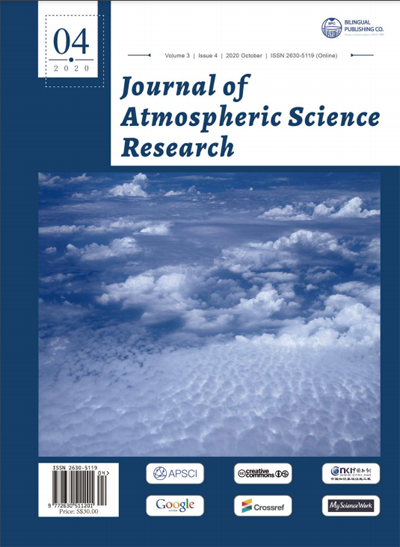-
2077
-
1496
-
1485
-
1357
-
1230
Corona with Streamers in Atmospheric Pressure Air in a Highly Inhomogeneous Electric Field
DOI:
https://doi.org/10.30564/jasr.v3i4.2342Abstract
The paper presents research data on positive and negative coronas in atmospheric pressure air in a highly inhomogeneous electric field. The data show that irrespective of the polarity of pointed electrodes placed in a high electric field (200 kV/cm), this type of discharge develops via ball streamers even if the gap voltage rises slowly (0.2 kV/ms). The start voltage of first positive streamers, compared to negative ones, is higher and the amplitude and the frequency of their current pulses are much lower: about two times and more than two orders of magnitude, respectively. The higher frequency of current pulses from negative streamers provides higher average currents and larger luminous areas of negative coronas compared to positive ones. Positive and negative cylindrical streamers from a pointed to a plane electrode are detected and successive discharge transitions at both polarities are identified.Keywords:
Positive and negative coronas, Atmospheric pressure air, Highly inhomogeneous electric field, ICCD camera, Ball streamer, Cylindrical streamerReferences
[1] L. Léger, E. Moreau, G. G. Touchard. IEEE T. Ind. Appl. 2002, 38(6): 1478.
[2] M. Simek, M. Clupek. J. Phys. D: Appl. Phys. 2002, 35(11): 1171.
[3] Y. S. Akishev, G. I. Aponin, M. E. Grushin, V. B. Karal’nik, M. V. Pan’kin, A. V. Petryakov, N. I. Trushkin. Plasma Phys. Rep. 2008, 34(4): 312.
[4] S. B. Afanas’ev, D. S. Lavrenyuk, I. N. Petrushenko, Y. K. Stishkov. Tech. Phys. 2008, 53(7): 848.
[5] D. Z. Pai, D. A. Lacoste, C. O. Laux, Jour. Appl. Phys. 2010, 107(9): 093303.
[6] M. Sabo, J. Páleník, M. Kučera, H. Han, H. Wang, Y. Chu, Š. Matejčík, Int. J. Mass Spectrom. 2010, 293(1-3): 23.
[7] T. Shao, V. F. Tarasenko, C. Zhang, D. V. Rybka, I. D. Kostyrya, A. V. Kozyrev, P. Yan, V. Y. Kozhevnikov, New J. Phys. 2011, 13(11): 113035.
[8] L. Liu, Z. Zhang, Z. Peng, J. Ouyang, J. Phys. Conf. Ser. 2013, 418(1): 012092.
[9] Y. Zheng, B. Zhang, J. He. Phys. Plasmas, 2015, 22(2): 023501.
[10] X. Li, X. Cui, T. Lu, Y. Liu, D. Zhang, Z. Wang. IEEE Trans Dielectr Electr Insul. 2015, 22(2): 1314.
[11] A. El-Tayeb, A. H. El-Shazly, M. F. Elkady, A. B. Abdel-Rahman. Plasma Phys. Rep. 2016, 42(9): 887.
[12] X. Zhu, L. Zhang, Y. Huang, J. Wang, Z. Liu, K. Yan. Plasma Sci. Technol. 2017, 19(7): 075403.
[13] V. F. Tarasenko, E. K. Baksht, E. A. Sosnin, A. G. Burachenko, V. A. Panarin, V. S. Skakun. Plasma Phys. Rep. 2018, 44(5): 520.
[14] Y. Guan, R. S. Vaddi, A. Aliseda, I. Novosselov. Phys. Plasmas, 2018, 25(8): 083507.
[15] Y. K. Stishkov, A. V. Samusenko, I. A. Ashikhmin. Phys.-Uspekhi, 2018, 61(12): 1213.
[16] R. Bálek and S. Pekárek, Plasma Sources Sci. T. 2018, 27(7): 075019.
[17] Q. Gao, X. Wang, A. Yang, C. Niu, M. Rong, L. Jiao, Q. Ma. Phys. Plasmas, 2019, 26(3): 033508.
[18] B. B. Baldanov, A. P. Semenov, T. V. Ranzhurov, Bull. Russ. Acad. Sci.: Phys. 2019, 83(11): 1366.
[19] Y. Guo, S. Li, Z. Wu, K. Zhu, Y. Han, N. Wang. Phys. Plasmas, 2019, 26(7): 073511.
[20] V. F. Tarasenko, V. S. Kuznetsov, V. A. Panarin, V. S. Skakun, E. A. Sosnin, E. K. Baksht. JETP Letters, 2019, 110(1): 85.
[21] N. G. C. Ferreira, D. F. N. Santos, P. G. C. Almeida, G. V. Naidis, M. S. Benilov, J. Phys. D: Appl. Phys. 2019, 52(35): 355206.
[22] W. Liu, Q. Zheng, M. Hu, L. Zhao, Z. Li. Plasma Sci. Technol. 2019, 21(12): 125404.
[23] Y. Cui, C. Zhuang, R. Zeng, Appl. Phys. Lett., 2019, 115(24): 244101.
[24] M. Cernak, T. Hoder, Z. Bonaventura. Plasma Sources Science and Technology. 2020, 29(1): 013001.
[25] L. Li, J. Li, Z. Zhao, C. Li. Phys. Plasmas, 2020, 27(2): 023508.
[26] L. B. Loeb. Electrical coronas, their basic physical mechanisms, Univ of California Press, 1965.
[27] Yu. P. Raizer. Gas Discharge Physics, Berlin: Springer, 1997.
[28] D. V. Beloplotov, M. I. Lomaev, D. A. Sorokin, V. F. Tarasenko. Phys. Plasmas, 2018, 25(8): 083511.
[29] G. W. Trichel. Phys. Rev. 1938, 54: 1078.
[30] V. S. Kuznetsov, V. F. Tarasenko, E. A. Sosnin. Russ. Phys. J. 2019, 62(5): 893.
[31] G. V. Naidis, V. F. Tarasenko, N. Y. Babaeva, M. I. Lomaev, Plasma Sources Sci. Technol. 2018, 27(1): 013001.
[32] V. F. Tarasenko, G. V. Naidis, D. V. Beloplotov, I. D. Kostyrya, N. Yu. Babaeva. Plasma Phys. Rep. 2018, 44(8): 746.
[33] V. F. Tarasenko. Plasma Sources Sci. Technol. 2020, 29(3): 034001.
[34] C. V. Nguyen, A. P. J. Van Deursen, E. J. M. Van Heesch, G. J. J. Winands, A. J. M. Pemen. J. Phys. D: Appl. Phys. 2009, 43(2): 025202.
[35] E. Kalered, N. Brenning, I. Pilch, L. Caillault, T. Minéa, L. Ojamäe, Phys. Plasmas, 2017, 24(1): 013702.
[36] A. Andronov, E. Budylina, P. Shkitun, P. Gabdullin, N. Gnuchev, O. Kvashenkina, A. Arkhipov. Journal of Vacuum Science & Technology B, Nanotechnology and Microelectronics: Materials, Processing, Measurement, and Phenomena, 2018, 36(2): 02C108.
[37] T. Shao, V. F. Tarasenko, C. Zhang, A. G. Burachenko, D. V. Rybka, I. D. Kostyrya, M. I. Lomaev, E. Kh. Baksht, P. Yan. Rev. Sci. Instrum. 2013, 84(5): 053506.
[38] S. Chen, L. C. J. Heijmans, R. Zeng, S. Nijdam, U. Ebert. J. Phys. D: Appl. Phys. 2015, 48(17): 175201.
[39] D. V. Beloplotov, V. F. Tarasenko, D. A. Sorokin, M. I. Lomaev. JETP Lett., 2017, 106(10): 653.
[40] D. A. Sorokin, V. F. Tarasenko, D. V. Beloplotov, M. I. Lomaev. J. Appl. Phys. 2019, 125(14): 143301.
[41] J. J. Lowke, F. D'Alessandro. Journal of Physics D: Applied Physics, 2003, 36(21): 2673.
[42] E. M. Van Veldhuizen, and W. R. Rutgers. J. Phys. D: Appl. Phys. 2003, 36(21): 2692.
[43] E. Wagenaars, M. D. Bowden, G. M. W. Kroesen. Physical review letters, 2007, 98(7): 075002.




 Victor Tarasenko
Victor Tarasenko





